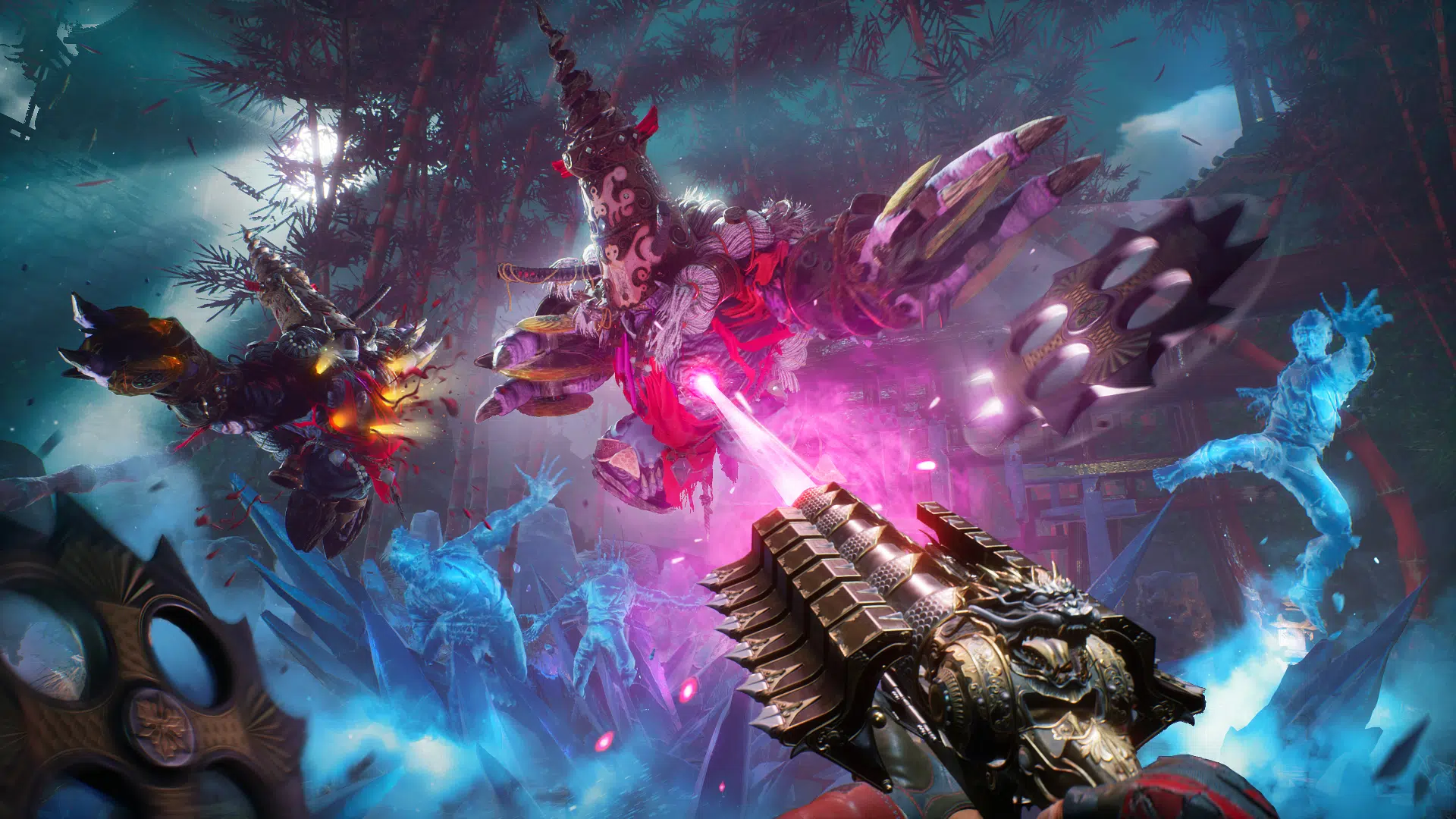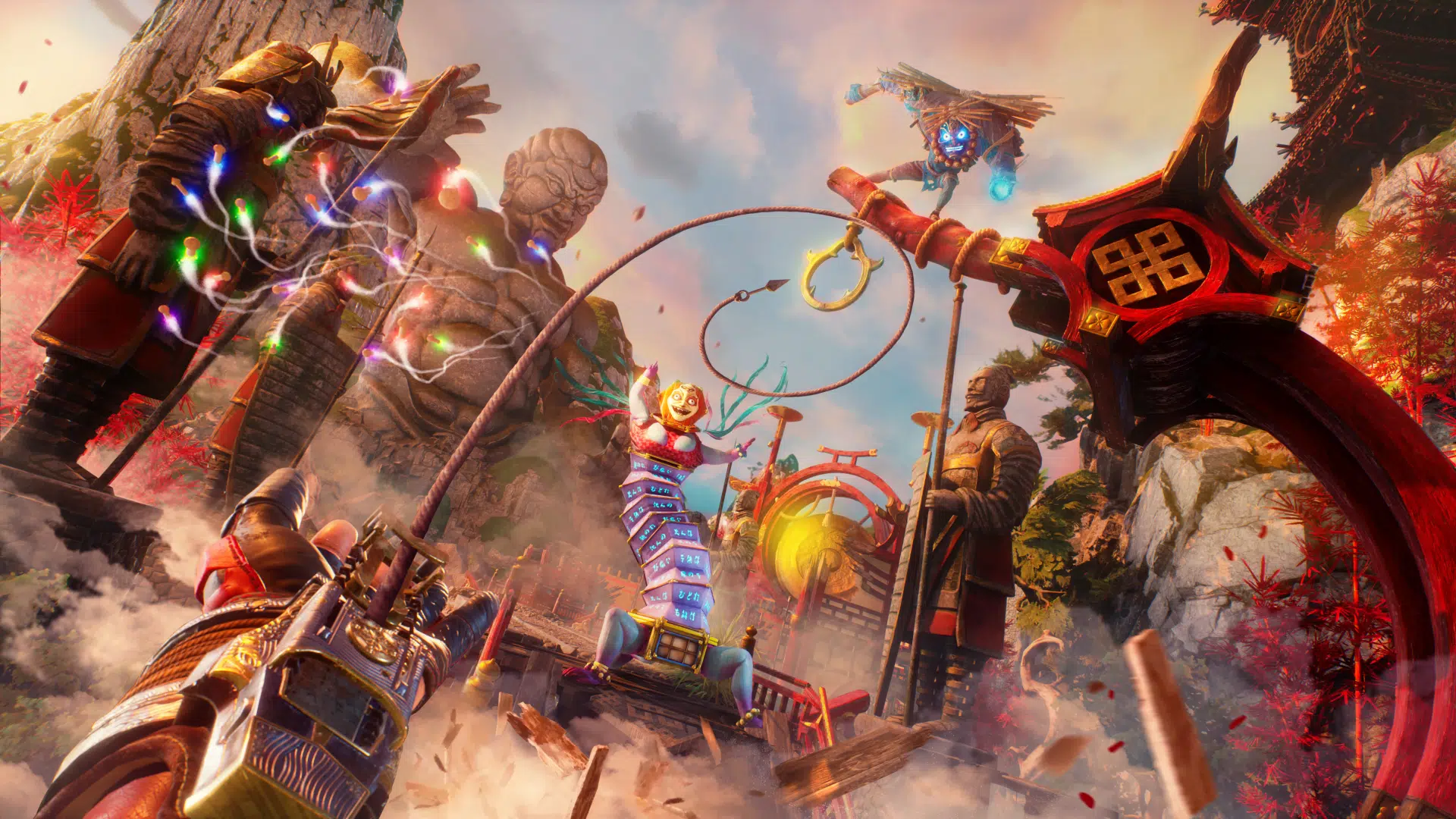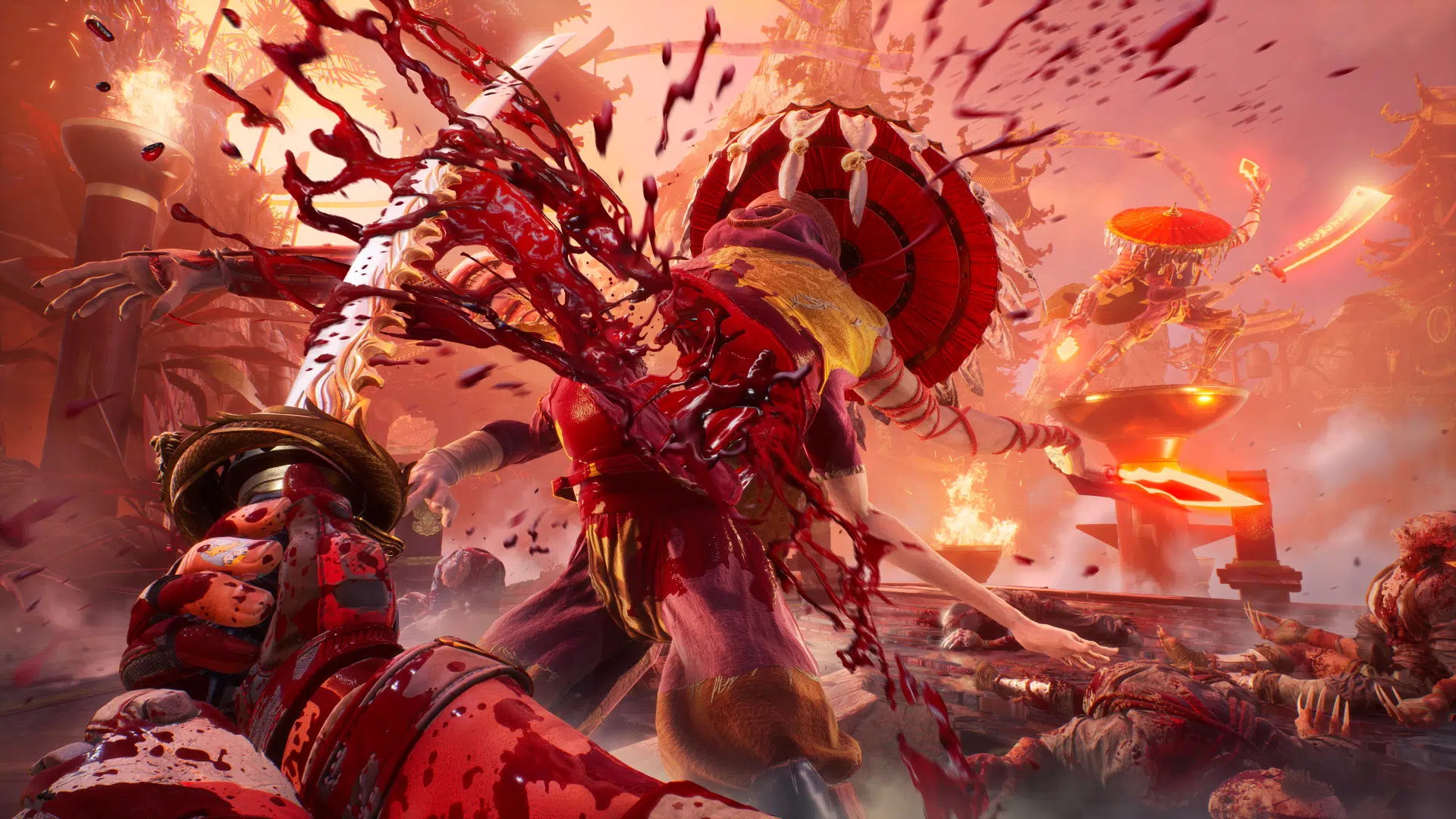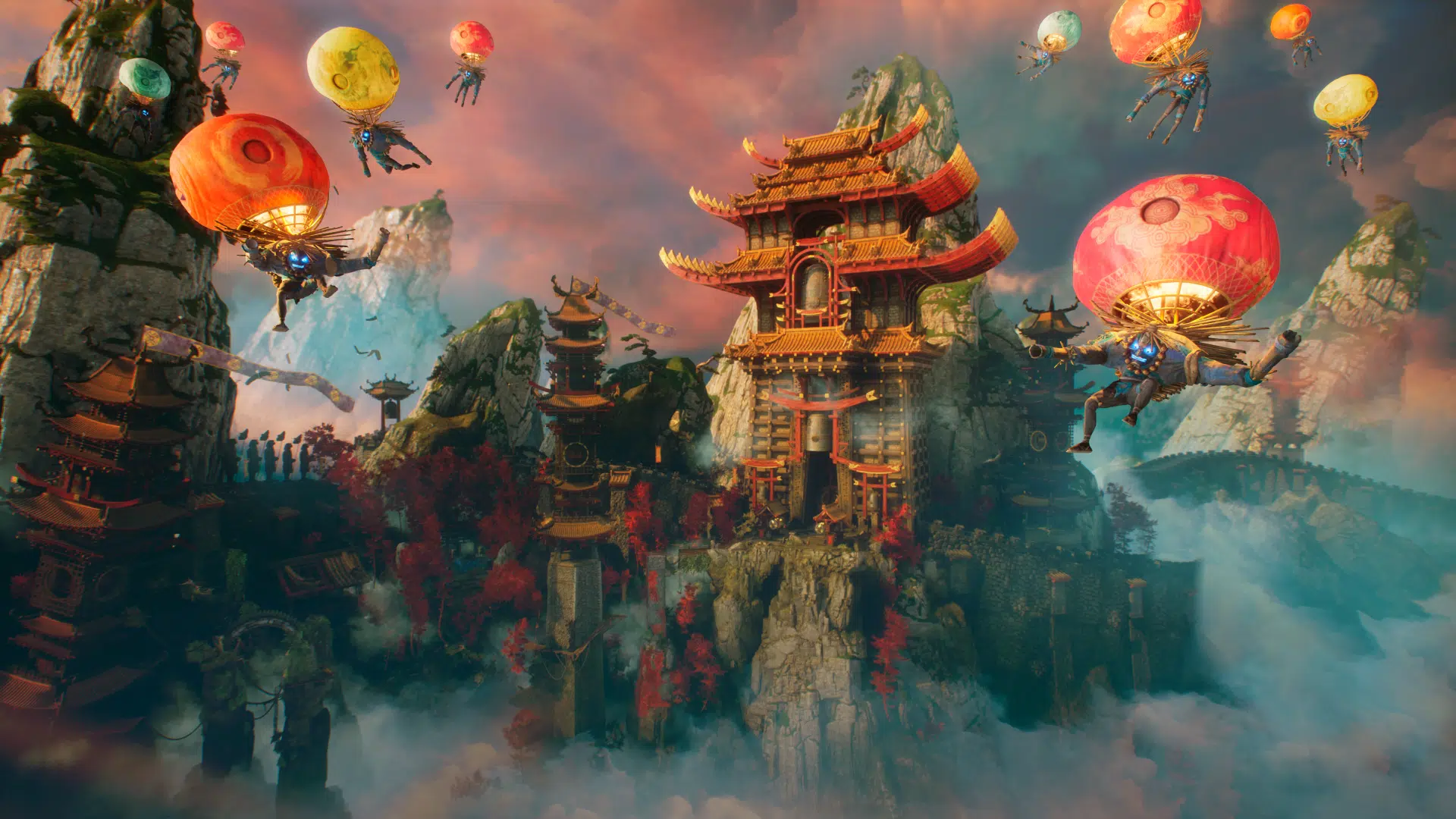Lo Wang is back for yet another exciting epic tale into the Shadow Warrior franchise. Armed with an arsenal of deadly weapons, including a limb slicing, blood-lusting Katana, Wang must venture through the end of the world, fending off demonic beasts, and a dragon of untold scale. A one man army, equipped with a mouth that cuts deeper than any blade, what could possibly go Wang, er, wrong?
Less RPG, More Classic Doom Roots
When I played the first Shadow Warrior back in 2013, I had nothing but high praise as the game managed to capture the perfect blend between both id Software’s Doom, and 3D Realms’ Duke Nukem and their original Shadow Warrior, though with its own unique identity carved by its excellent swordplay, parkour action, and of course, it’s offensive beat of crude one-liners. It was, in the best way to describe it, Doom but with a sword and the banter and crude humor of Duke Nukem.
Fast forward to the 2016 follow-up, Shadow Warrior 2. Flying Wild Hog was looking to bring a fresh take to the franchise. How? By gearing the gameplay around a looter experience and introducing co-op in a semi-open world with procedurally generated levels. As a fan of the first, it certainly was a bold change, one that left me with some rather mixed feelings as the RPG and looter mechanics felt more of a second thought as they were easy to ignore…still a fun game, mind you.
The co-operative play however was a great highlight, as it further reinforced the exhilarating combat brought from the first, only this time with friends.
And that brings us to the third Shadow Warrior, yet another iteration that Flying Wild Hog is looking to sprinkle some fresh takes, though in a more interesting way.
While it’s common for sequels to build upon past mechanics, Shadow Warrior 3, as disappointing as it may seem, sheds away its semi-open world, as well as cooperative play, to instead focus on returning to the series’ roots. The results? An 8-10 hour long linear campaign that is more personal, and perhaps filled with some of the best gameplay in the series yet.
Level progression has been scaled back, no longer being about what kind of builds you can make, or how much grinding you have to do to farm specific items. Instead this has been replaced with a much simpler system of upgrading that’s natural to the flow of the campaign. As you progress, you unlock new guns, new upgrades, and new skills. No longer a game of luck and grinding, and much more in line with the first Shadow Warrior (2013).
And as mentioned before, Shadow Warrior 3 does away with its semi-large open world with procedurally generated zones in favor of linearity. While some may gawk at that, personally, I think this was for the best, as it has allowed Flying Wild Hog to get more creative in Shadow Warrior’s diverse environments.
Traversing, for example, feels the utmost best, as it’s a breeze to run through environments and all their interconnected points. That’s mostly thanks to how Flying Wild Hog has built areas to support a dense amount of verticality. And being that you are a ninja after all, expect to be scaling massive structures filled with wall running, and tons of platforming.
It does help that Shadow Warrior 3 introduces a grappling hook for the first time in the series, something that a lot of games as of late are doing. I love this addition, as it makes areas fun to swing around in, and the action to grapple on points (and even enemies) is so seamless, as it’s a simple button press.
Environments aren’t the only thing affected by the focus of verticality either, as it plays a major role in the combat itself. Many of the Doom-like arenas where combat takes place are littered with points of scaling, wall running, and even grappling points. You can take the battle high, or you can take it low, whatever it is, you’ll be sure to find that there is a robust amount of freedom in the approach.
The weapons, like past iterations, come in plenty, and are as deadly as they are creative as ever. Take The Outlaw, a fast shooting revolver with bullets capable of shooting limbs right off. It’s the first gun you get, and as you progress you can slot it with different upgrades such as one that ignites enemies on fire, or my favorite the Poppin’ Head upgrade, which makes enemies head explode as a flood of blood rushes out of their body.
Another one of my favorites is the akimbo SMG. They don’t do as much damage as the other guns, but they’re loads of fun because of how bloody of a scene they cause.
However, despite some of the other weapons being a bit more explosive and flashy, I still think none of them compare to the Katana, which is at the center of all the gameplay.
If a concern that players had was that Flying Wild Hog would be “dumbing” down the Katana gameplay, or lessening the gore it attributes, well, you can rest easy because this is perhaps the deadliest we’ve seen it yet. Often during my playthrough I would come across hordes of enemies, and while logically using a gun would have made more sense, it was just too much fun in the way body parts get cut off.
Heads will fly, legs will roll, and arms will flail as you slice away at an enemy. The amount of blood that seeps out of them is ridiculously over-the-top. Yet, no matter how many limbs I’ve seen, how many mutilated corpses, or deep gashes that made me go “holy shit,” I always had a smile. It’s fantastic, and fans will undoubtedly love it.
Furthermore, there are executions that the player can perform. For those who played Doom, you’re probably familiar with the gorefest that follows, but Shadow Warrior 3 takes things to the next level. I’m almost reminded of the fatalities in Mortal Kombat when it comes to executions. Heck, there’s even a slight pause before the character actually performs it (as if someone is saying “FINISH HIM” in the back of your mind).
Every single enemy in Shadow Warrior 3 has their own unique execution that is just an absolute bloodbath to witness. On one enemy I ended up ripping their head out from their body, with their spine attached still. As I held their lifeless head with both hands, the execution ended with their head being crushed in. Just absolutely brutal.
What makes these executions even more worthwhile to perform is that some enemies will grant one-time use weapons. Take the Oni Hanma, a brute with a large stone fist. During an execution they will have their stone fist cut off, in which the player can use it to bash other enemies head in. There is another Yokai with a drill on their face that will literally be ripped out, pulling all their internal organs just so you can drive this through the chest of others. Throwables can also be uncovered through means of executions, some freeze, some act as lasers, and others as explosives.
And going back to the whole verticality talk from earlier, stages are also littered with various traps, both high and low. Often I would find myself overwhelmed by enemies, only to notice a small interactive “shoot point” in the distance that controlled a massive saw blade close by. Shooting it caused the blade to spin viciously, shredding all the enemies who dared stepped in its path. Again, a lot is crammed in these linear environments, offering a ton of freedom for the player. It’s like the phrase says, sometimes less is more, and Flying Wild Hog certainly makes the most out of these small spaces they’ve crafted.
An Impressive Face Lift
With the focus now shifted back to a linear presentation, Flying Wild Hog has managed to introduce a number of big improvements, some of which I’ve already discussed above, but I wanted to talk about the visual presentation itself. Having played the last two Shadow Warriors, I’ve never considered the series to be much of a visual spectacle. I mean, it looked good, but it wasn’t exactly something I’d write home about or show my friends to try and impress them.
Well, that changes with Shadow Warrior 3, as it bolsters a new art direction that is rich in vibrant coloring, as well as variety of environments.
The visuals look fantastic as palettes of beautiful color gradients splashed over every location I visited. Lush greens filled overgrown jungles, while a cool blue breeze ran through gorgeous mountain vistas. What I especially loved is the use of neon colors being tied to effects such as bullets and sword slashes, giving the gameplay a very stylish look.
What’s more impressive are the animations themselves, moreso specifically on the enemies. They don’t appear stiff or lifeless at all. Enemies such as the Gassy Obariyon who are “overweight” pigs have parts that bounce and jiggle around as they move, whereas some of the more complicated enemies such as the Slinky Jakku have an accordion like appendix that folds in and out as they hop around from spot to spot. They’re not the kind of details, or animations you would come to expect out of an enemy outside of a boss.
As for performance, running Shadow Warrior 3 at max setting was a pretty easy task on my 3080 Ti build, producing some flawless performance in not just visual fidelity, but in the framerate itself. While there was an option to opt with uncapped fps (frames-per-second), I decided it would be best to experience with a locked 60fps, which Shadow Warrior 3 seemed to have held even during the intense packed action moments.
Of course my GPU is on the higher end of things, which luckily Shadow Warrior 3 isn’t at all a demanding game. The minimum requirements are either a Nvidia GTX 760, or a AMD Radeon R7 RX270, cards that are nearly a decade old. Of course you shouldn’t expect to run Shadow Warrior 3 at max with those cards, but they should be an indication of what kind the game is on players’ hardware.
Look, It’s Me. I’m Here. Deal With It. Let’s Move On.
Perhaps the most drastic change that has Shadow Warrior fans on the divide is that the main protagonist, Lo Wang, is no longer voiced by Jason Liebrecht. The reasoning, as provided by Devolver Digital (via PCGamer) was due to originally casting a voice actor who didn’t fit the background of Lo Wang’s culture. Regardless of my opinion on that matter, I will say that the change in voice acting isn’t as bad as the trailers make it out to seem, albeit the game’s crude humor and writing helps.
Mike Moh, who you may recognize as the actor who played Bruce Lee in Once Upon a Time in Hollywood is the new voice of Lo Wang, and his performance is a pretty solid one. Lo Wang’s accent may not be as deep and over exaggerated as before, but it certainly is still there, as well as the mix of sarcastic emotions he has displayed in past iterations.
Starting the story off, Lo Wang is at a very low-point in his life, having lost his best friend and unleashing a world-ending dragon. There’s not a lot of hope for him left, no reason to keep fighting. The joke is over for him, or at least that’s what it seems until a familiar face pops up, giving him a new purpose to keep on fighting. Now reignited with a new passion, Wang decides it’s time for him to crawl out of the hole (both literal and metaphorical) he dug himself in, as he once again prepares to face off against the impossible in order to save the world. He’s the world’s last hope and he knows it, yet despite this being a very serious matter, he, himself, is not so serious about it.
Mike Moh portrays that pretty well as evident in the opening scene and throughout my nine-hour run. Sure, it’s not Jason Liebrecht, but I do think in a respectful manner that Moh does a great job at attempting to emulate the original voice. There’s a bit of personality from what we loved about Jason’s performance that Moh certainly shows with his rendition of Lo Wang. If it bothers you, I do understand, but I think the game’s writing saves a lot of the problems you may have with it. It’s not a change I’m too bothered by, as long as the new actor is able to deliver, which Moh has. He’s sarcastic, witty, offensive, as well as relatable, qualities Wang had in the last two games thanks to Jason’s performance.
I’ll say to long-time fans, give the new voice actor a chance, who knows? you might just end up being surprised (or not).
Verdict
Shadow Warrior 3 represents a true return to the series roots, rekindling the very reason why many loved the first as well as the classic titles it inspires from. There are plenty of small and big improvements, and while I am disappointed by the fact that I won’t be able to experience this with a friend or two, it’s compensated by what Flying Wild Hog was able to deliver on. It’s a fantastic game that calls back to the mindless fun that we all had when we were growing up, filled with the crude humor that modern day gaming dares to no longer do.
Score: 8.5/10
Pros:
- Stylishly fun and addictive gameplay that has us wanting to come back for more.
- Gore system is satisfyingly out of this world.
- Weapons are unique, and all fun to use. The katana takes the spotlight undoubtedly.
- Visually the best looking Shadow Warrior game to date, with a rock solid performance to accompany.
- Crude, sick humor doesn’t take a backseat, even if some don’t always hit.
- A return to form, all focused on a simpler level of progression and no longer about grinding for specific loot.
Cons:
- Lack of co-op is still disappointing.
- Not a lot in terms of replayability, Which may be a disappointment to those coming from Shadow Warrior 2.
Shadow Warrior 3 review code was provided by the publisher. Version tested PC. You can read MP1st’s review and scoring policy right here.




